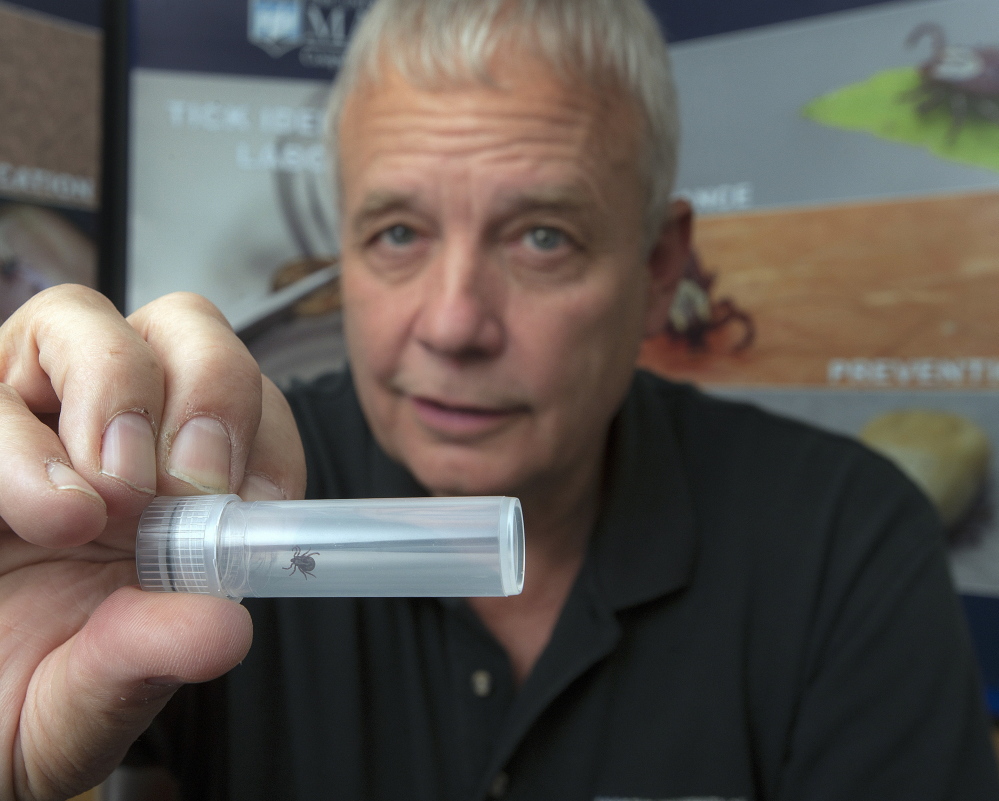Jim Dill is a pest management specialist with the University of Maine Cooperative Extension. He has also served in the Legislature since 2010, including as the chair of the Agriculture, Conservation and Forestry Committee. On Tuesday, he won the primary to be a Democratic candidate for the state Senate. Dill is the man you go to when you want to talk about ticks. And other insects; we caught him as he was just returning to the UMaine Extension tick ID lab in Orono after dealing with a fly problem at the Department of Agriculture (possibly manure-related).
YES, HE HAS MORE TO WORRY ABOUT THAN EVER: “I didn’t know what a tick was, growing up in southern Maine,” Dill said. Now they’re everywhere. Climate change “probably has something to do with it,” he said. In an average year, about 100 people come into the lab asking for tick identification. “We are already at 70 this year, and people haven’t been out and about because it has been so wet and nasty,” he said.
CAN WE BLAME THE WINTER? “I don’t believe the cold, snowy winter has had much of an impact on the tick population,” Dill said. That cold wet spring isn’t helping, however. “Tick populations do need high humidity,” he said. If he puts a tick in a dry vial, it will be dead in 24 hours. “But if I put a piece of rolled up paper towel in, then it will be fine the next day.”
HEALTH QUIZ: HAS HE HAD LYME DISEASE? “I’ve been treated twice for Lyme,” Dill said. “Both times because I had a ring rash” (which less than 50 percent of people with Lyme develop). “It’s kind of an occupational hazard for me because I’m out in the habitat.”
WHAT TO EXPECT WHEN YOU DEVELOP A TICK EXPERTISE: Many ticks, delivered to your door, or rather, the Cooperative Extension laboratory. “One guy just dropped off about 150 ticks preserved in Bombay gin of all things,” Dill said. “I asked him, ‘Is this like the tequila worm?’ ” The gentleman, who picked them off his dog, told him he’d decided he didn’t care for Bombay, and “this was as good a use as any for it.” The lab preserves all specimens for a year in case the person who left them gets sick later and wants the tick for testing.
DOES THE STATE TEST THE TICKS FOR LYME? No, the lab is equipped only for identification now, for a $10 fee. Since in Maine most ticks are deer (98 percent, Dill said), odds are that’s the culprit. And so far in Maine, those are the only ticks that carry Lyme. Doctors don’t like to prescribe antibiotics for young children if it’s not completely necessary. But if Dill says, yes, it is a deer tick and yes, it has been feeding, “that may change the doctor’s mind.” Dog ticks make up 1.9 percent of the tick population. They’re bigger but it can be tricky to tell the two apart when engorged; the deer tick swells up to about the same size. A bond issue on the November ballot, signed by Gov. Paul LePage this April, will ask voters to approve $8 million to fund a new diagnostic lab at the extension. (In November 2012, a $11.3 million bond that included such a lab was rejected by voters.) Dill is rooting for it and he hopes others will too: “The whole tick and bed bug issue has become so rampant in the last five years,” he said. “It’s really on the forefront of people’s minds.”
THE OTHER 0.1 PERCENT OF THE TICKS, WHAT ARE THEY? “There are 14 species of ticks in the state of Maine,” Dill said. The winter ticks are making the state’s moose miserable because they don’t drop off after feeding, staying on all winter. (According to estimates, 30 percent of the Maine moose herd may have perished this year, many possibly dying from exposure after rubbing off their fur on trees in an attempt to shed ticks.) Others include the rabbit, squirrel or woodchuck ticks. The woodchuck tick carries the rare and powerful Powassan virus, which last year killed Rockland artist Lyn Snow.
IS THERE A NON-CHEMICAL WAY TO FIGHT OFF TICKS? “On pets, I am not really sure there is,” Dill said. But with humans, there might be some hope for rosemary oil. “Maine Medical Center is looking at it both as a repellent and as a spray to actually kill the ticks.”
ANYTHING ELSE WE CAN DO? (CAN YOU TELL WE’RE DESPERATE?) Cut back plantings around the foundation of your home. “Heavy foliage actually harbors deer ticks quite nicely,” Dill said.
THE CREEPIEST TICK STORY OF THE MONTH: “Two weeks ago, we had a guy bring in a partially engorged deer tick he’d found on his seven-day old baby,” Dill said. “It was right behind his ear.” Once he knew for sure what he was dealing with, the Bangor- area dad took the tick away to be tested for Lyme.
Send questions/comments to the editors.




Comments are no longer available on this story